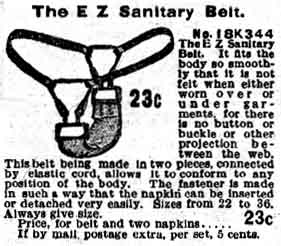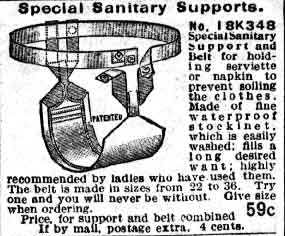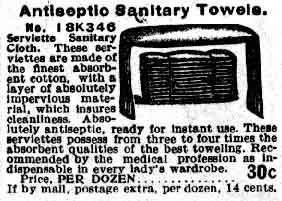Early 20th-century Japanese
ads from publications - open-crotch drawers,
1890s (U.S.A., from MUM collection) - Modess "Sanitary
Shield" (two-band pad holder in
crotch; 1970s; U.S.A.) - SheShells bikini
(snap open at sides; no special crotch;
possibly for menstrual pads or tampons,
1970s, U.S.A.)
See Kotex ad with a man and no woman
from the Netherlands
Compare the American "Modess,
because . . ." ads, a French Modess ad,
a French ad featuring just a man!,
and ads for teens.
See Kotex items: First ad
(1921) - ad 1928 (Sears
and Roebuck catalog) - Lee Miller ads
(first real person in amenstrual hygiene ad,
1928) - Marjorie
May's Twelfth Birthday (booklet for
girls, 1928, Australian edition; there are
many links here to Kotex items) - Preparing for
Womanhood (1920s, booklet for girls;
Australian edition) - 1920s booklet in
Spanish showing disposal
method - box
from about 1969 - "Are
you in the know?" ads (Kotex) (1949)(1953)(1964)(booklet, 1956) -
See more ads on the Ads
for Teenagers main page


|

Menstrual napkin belts and pads
from the 1902 and 1908 Sears,
Roebuck catalogs (U.S.A.)
In America, women could buy
commercial menstrual belts at
least by 1891 (see the Jordan,
Marsh & Co. catalog).
Before that time, women probably
made their own menstrual gear
based on patterns handed down from
mother to daughter or from the
many books advising women how to
run a household (see a German pattern),
the chief occupation of
middle-class women. Or they simply
used old rags or other absorbent
material - or used nothing at all,
but bled
into their clothing.
|
Sears offered
the belts and washable pads
below through its 1908 catalog. See a 1902 belt
below this section.
|
|
|
|

|
|

|
|

As the
ad states, above, women could wear
a belt over some underpants
(drawers) because one style, the
older one, had an open crotch,
allowing the pad to pass through
the opening and press against the
vulva (see drawings).
Open-crotch underpants would soon
disappear as fashion made sitting
on a toilet less trouble, what
with less
cumbersome dresses (picture of
girl at left) (this is my
theory).
Not to put too fine
a point on it, but women wearing
the huge dresses of the time - see
the drawing, at right, from the
catalog in question - found it
much easier just to sit, thereby
widening the already wide crotch
opening and putting the lady into
firing position, if you will (or
even if you won't). No need to
reach under the dress and pull her
underpants down.
(I don't know how
or if women wiped themselves
afterward; the dress itself would
easily trap odors, so maybe it was
not considered to be important.
And people bathed much less in
1908; everyone itched and
scratched and hurt much more than
today. I did not see toilet paper
or holders for it in the bathroom
pictures or listings in this
catalog).
And there was
little danger that anyone could
peek up her dress (see her foot),
so an open crotch was safe,
although the lower part of the
drawers was often decorated, maybe
for the chance glimpse. Just one
guy's opinion.
Drawing of lady
in dress, at right, from the
catalog:
A nicely dressed woman in 1908 had
a lot to fuss with when she sat on
a toilet. And can you imagine
changing a pad, one she would save
in order to wash, attached to the
pad holders on this page?
Inserting and removing a tampon
would have been even more
difficult, maybe impossible
without undressing, requiring a
good aim while spreading the
vulva. This style of clothing may
have helped delay the appearance
of the commercial
tampon, which probably
surfaced in the U.S.A. in the
early 1930s. (The 1908 Sears
catalog called this dress "AN
EXTREMELY STYLISH SHIRT WAIST SUIT
OF CHIFFON TAFFETA SILK," and I
know it's not correct to say so,
but it's beautiful, as is the
model and her hair.)
Two examples of pads bending to
fashion are the panty
pad
for thongs and stick-in
pads for tight-fitting
underpants, which apparently
appeared in the mid-1930s.
And read the 1927 report
of Dr. Lillian Gilbreth to
Johnson & Johnson to see how
women wanted pads to fit current
fashion.
|

See an interesting chart
from 1923 showing a
proposed relationship
between dress length,
etc., and painful
menstruation, in Woman's
Physical Freedom,
a book by Clelia Duel
Mosher, M.D.
|
|

The ads continue
below.
|
|

|
|

|
The
ad below - I
broke it in two because
of its size - came
from the 1902
Sears, Roebuck catalog.
Remember that the first
successful disposable
menstrual pad, Kotex,
appeared in advertising
in 1921, so women
in 1902 had to wash
their homemade or
store-bought pads, often
first letting them soak
overnight, perhaps in a
bucket under a sink, to
loosen the dried blood.
(You can do that today,
too, with modern washable
pads.) Sears
sold ready-made
washable cotton pads,
as you read at the
bottom of the ad text.
Readers
could also buy a douche
liquid, "sanitive wash," for
cleaning out the
vagina after
menstruation (Mrs.
Pinkham sold a
"sanative" wash - note
the difference in
spelling in the list
of
her products -
also a douche liquid.
See more douche
liquids.)
Sears sold many
varieties of douching
apparatus for decades,
sometimes probably intended
for killing sperm
after intercourse,
since the U.S.A.
tightly restricted
abortion and
contraception. (Read
about and
see a later douche
bulb, and
read why it's
not good to douche.)
Customers in 1902 knew
their Roman mythology
better than most of us,
and Venus and Diana,
which Sears called
another style of belt,
were goddesses chosen to
appeal to the ladies,
Diana being associated
with the moon and thus
menstruation. And who
wouldn't want to be
linked with Venus,
secretly anyway?
The ad calls this "the
only practical
protector,"
also in the similar ad
above; this is odd,
since Sears sold others,
although significantly
not on the same page.
Ah, the world of
marketing!
|
|
|
|
|

|
|
© 2001 Harry Finley. It is
illegal to reproduce or distribute
any of the work on this Web site
in any manner or medium without
written permission of the author.
Please report suspected violations
to hfinley@mum.org
|
|